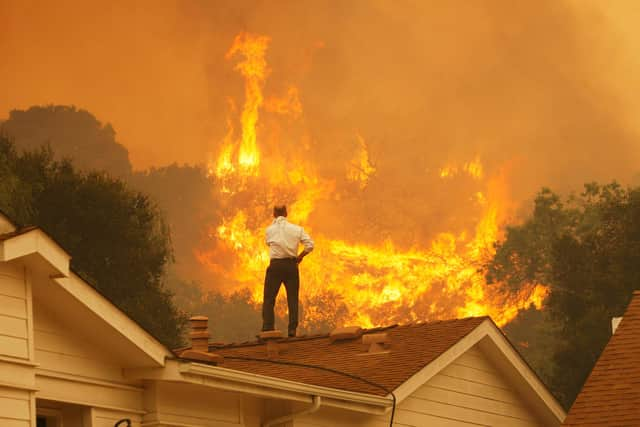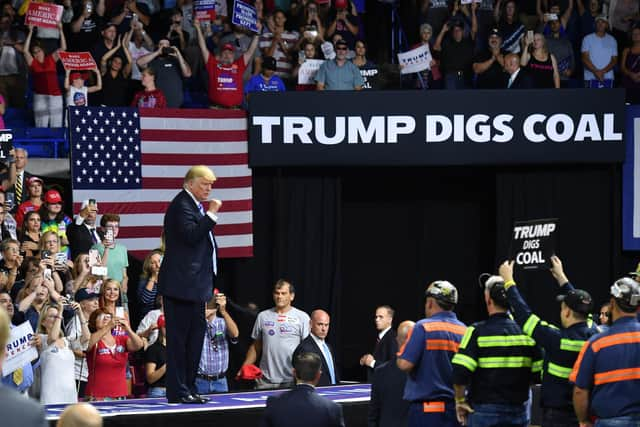COP26 summit: World can learn from US states who defied Donald Trump over climate change – Nicola Sturgeon and Mike Bloomberg
A four-year drought pushed southern Madagascar to the brink of climate-induced famine. A one-in-1,000-year heatwave scorched the normally temperate Pacific Northwest.
Climate change is no longer a distant, future threat. It’s already here, and it is already causing damage to communities around the world.
Advertisement
Hide AdAdvertisement
Hide AdAs global temperatures continue to climb, the effects on our planet and its 7.7 billion inhabitants will only get worse. As sea levels rise and the world continues to grapple with even more extreme droughts and fires, heatwaves and natural disasters, millions more people will be pushed out of their homes and communities.
The good news is, we still have it in our power to stave off the worst-case scenario. And the latest science shows us what that would take. The world must achieve net-zero emissions by 2050.
And we must achieve much of these reductions over the coming decade if we are to keep alive the Paris Agreement goal of limiting warming to 1.5 degrees Celsius above pre-industrial levels.
We can still achieve this, but not at the pace we are going. Countries must be bolder and move faster to meet ambitious near-term targets to reduce emissions.
At the UN climate change conference, COP26, national governments are presenting their latest plans for meeting the global targets set by the 2015 Paris Agreement. But it’s critical to remember that it’s not just large nations that will determine whether we succeed in tackling the climate crisis effectively. Not only is the problem too big, but many of the solutions lie in the hands of other actors, from states and cities to businesses and other civic organisations.


We need to work together to agree ambitious actions and the finance and resources needed to deliver them. Governments at all levels – from devolved nations like Scotland to states and local and city administrators – can help accelerate climate progress by working hand-in-hand with the private sector to set the pace.
There’s a clear logic to this – it is these governments that are often closest to the consequences of climate change. They’re the ones who must respond to floods, fires and heatwaves – and their citizens are demanding action.
These groups also exert great control over many of the key areas of greenhouse gas emissions, from building regulations to transportation policy. Altogether, up to 80 per cent of climate mitigation and adaptation actions will be implemented at the sub-national or local levels. The more national governments and the international community collaborate with them to act, the more progress we can achieve.


Advertisement
Hide AdAdvertisement
Hide AdIn the United States, in order to fill the leadership vacuum left by the Trump administration, Bloomberg Philanthropies helped convene state and city governments, along with businesses, to take climate actions that helped the US stay on track to meet its commitments under the 2015 Paris Agreement, even without any help from Washington.
And today, as US President Joe Biden works to expedite the retirement of petrol-powered vehicles, this group is working with the federal government to achieve 100 per cent clean energy even sooner than the federal government has committed to doing.
Scotland’s climate leadership also demonstrates how a smaller nation can achieve deep emissions reductions by setting their own ambitious, legislated targets. Scotland has published its own indicative Nationally Determined Contribution in advance of COP26, including a world-leading statutory target of a 75 per cent reduction in emissions by 2030 on the way to net-zero by 2045.
And Scotland has already more than halved greenhouse gas emissions from 1990 levels – that’s faster than any G20 country. Crucially, Scotland is working to ensure a just transition to net zero, making sure no-one is left behind.
If we are to fully maximize the opportunity the COP in Scotland’s largest city, Glasgow, presents, then we need states and regions from around the world to come together and set the pace of climate ambition.
One way they can do this is by joining the Under2 Coalition, a network of state and regional governments, which is committed to achieving net-zero emissions by 2050. Ahead of COP26, we urge states and regions around the world to become a part of this movement and to join the Race to Zero campaign, which unites states, cities, businesses, and universities in joint pursuit of climate leadership.
By sharing best practices and lessons learned, this growing network can turbo-charge the world’s efforts to reduce emissions. To help do that, it is imperative for national governments to invite states and regions to participate in the design of national climate targets and plans. By working together, governments of all types can expand the level of ambition and ensure the collaboration that will be needed to implement and achieve targets.
Most effort in developed countries is currently on mitigation – on averting the worst impacts of the global climate crisis by reducing emissions. Increasingly, and importantly, there is now a focus on adaptation too – on ensuring we can live with the changes that are inevitably to come.
Advertisement
Hide AdAdvertisement
Hide AdThat’s why we are also inviting states and regions to join the Race to Resilience. This campaign is building resilience to help protect the four billion people who are most vulnerable to climate shocks – helping their communities adapt to extreme heat, drought, and flooding.
It is already too late for us to avert climate change. But it is not yet too late for us to protect our communities and our children from its very worst possibilities and to prepare for the impacts which can’t now be avoided.
That demands leadership from everyone, and devolved, regional and state governments are ready to do so much more – and do it now.
Nicola Sturgeon is Scotland’s First Minister; Mike Bloomberg is an entrepreneur, ex-mayor of New York City, and UN Secretary-General's Special Envoy for Climate Ambition and Solutions
A message from the Editor:
Thank you for reading this article. We're more reliant on your support than ever as the shift in consumer habits brought about by coronavirus impacts our advertisers.
If you haven't already, please consider supporting our trusted, fact-checked journalism by taking out a digital subscription.
Comments
Want to join the conversation? Please or to comment on this article.
